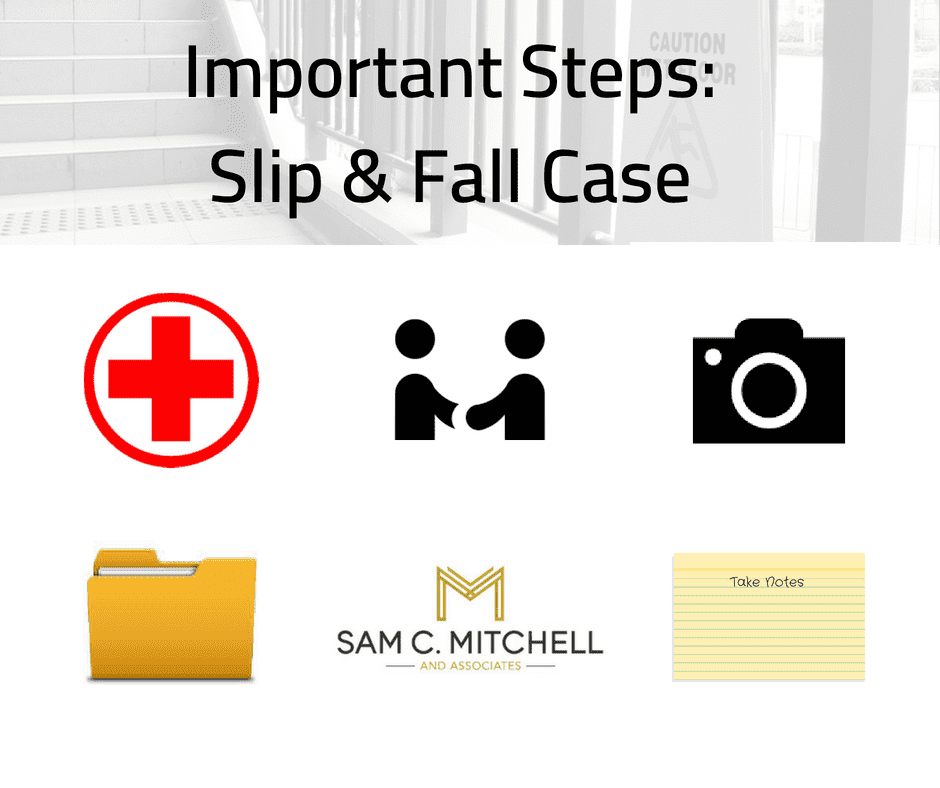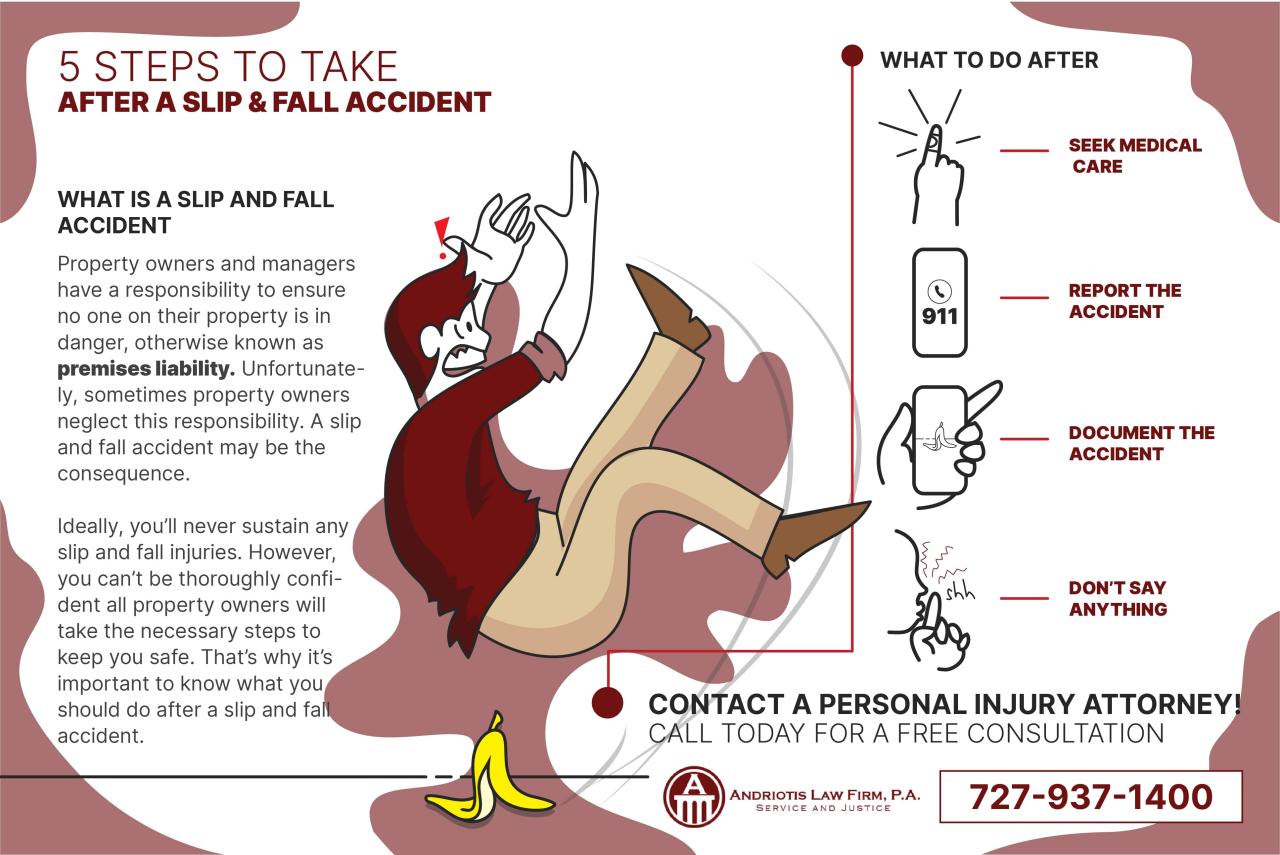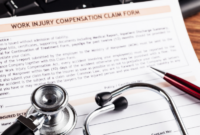Steps to Take After a Slip and Fall to Strengthen Your Case: A seemingly minor slip and fall can quickly escalate into a complex legal matter. Understanding the immediate actions to take after such an incident is crucial for protecting your rights and building a strong case. This guide Artikels the essential steps, from documenting the scene to communicating with insurance companies, ensuring you’re prepared for whatever comes next.
Navigating the aftermath of a slip and fall requires a proactive and organized approach. Proper documentation, prompt medical attention, and strategic communication are key elements in building a successful claim. This detailed guide provides a clear roadmap to help you understand your rights and responsibilities following a slip and fall accident.
Immediate Actions After a Slip and Fall

Following a slip and fall accident, your immediate actions are crucial for both your safety and the strength of any potential legal claim. Prioritizing your well-being while systematically documenting the incident is key. This involves a careful balance of self-care and evidence preservation.
After a slip and fall, immediately report the incident and seek medical attention. Document everything meticulously, including photos of the hazard. Understanding employer responsibility is key; for instance, you might need to demonstrate negligence, as explained in this helpful resource on Employer Negligence: Proving Fault in Workplace Accidents. This understanding will strengthen your case significantly when proving that the employer failed to provide a safe working environment, contributing to your fall.
Documenting the Accident Scene
Thorough documentation of the accident scene is paramount. This involves a detailed record of the environment, the circumstances of the fall, and any visible injuries. Remember to remain objective and avoid making assumptions or subjective interpretations. Focus on factual observations. Using a combination of written notes, photographs (if possible and safe to do so), and witness statements will provide a comprehensive record.
Following a slip and fall, immediately document everything: injuries, witnesses, and the accident scene. Seeking medical attention is crucial, as is reporting the incident to your employer. Understanding the potential compensation you might receive is key; to learn more, check out this resource on How Much Compensation Can You Get for Workplace Injuries. This knowledge will help you effectively pursue your claim and ensure you receive the support you deserve after your workplace accident.
Remember to keep all medical records and communication with your employer.
Creating a Detailed Account of the Accident
When documenting the accident, aim for accuracy and completeness. Describe the location precisely, including specific landmarks or building features. Note the lighting conditions, the type of surface you fell on (e.g., wet tile, uneven pavement), and any obstacles present. Detail the sequence of events leading up to the fall, including your actions and the conditions you encountered. If possible, note the presence of any witnesses.
Describe your injuries objectively, noting the location and severity of any visible wounds. Avoid emotional language; stick to clear, concise descriptions.
Example Accident Documentation, Steps to Take After a Slip and Fall to Strengthen Your Case
The following table provides an example of how to document the accident chronologically. This type of meticulous record-keeping is essential for building a strong case.
| Time | Action Taken | Person Involved | Observation |
|---|---|---|---|
| 14:35 | Entered grocery store. | Self | Store floor appeared dry and clean. |
| 14:40 | Slipped on a wet spot near produce section. | Self | Fell to the ground, hitting right knee and elbow. Observed a small puddle of liquid (unidentified) on the floor. |
| 14:42 | Called for assistance. | Self | Store employee, Jane Doe, responded. |
| 14:45 | Jane Doe assisted in standing up. | Jane Doe | Observed visible bruising on right knee. |
| 14:50 | Employee called store manager. | Jane Doe | Store manager, John Smith, arrived and took notes. |
| 15:00 | Left the store with assistance. | Self, Jane Doe | Store manager noted the wet spot. Employee obtained contact information. |
Reporting the Incident and Gathering Evidence

Promptly reporting a slip and fall incident is crucial for preserving your legal rights and building a strong case. The initial report sets the stage for further investigation and claim processing, so accuracy and thoroughness are paramount. Gathering supporting evidence concurrently enhances the credibility of your claim.Following a slip and fall, you should immediately report the incident to the property owner or manager.
After a slip and fall, immediately report the incident and seek medical attention. Document everything meticulously, including witness statements and photos of the accident scene. Understanding your rights regarding workers’ compensation is crucial, and this is where seeking legal counsel becomes vital; for instance, learn more about how How Attorneys Help with Workers’ Compensation Claims can benefit you.
This proactive approach, coupled with legal expertise, significantly strengthens your case for compensation.
This can be done in person, by phone, or in writing. Obtain the name and contact information of the person you reported the incident to. Document the date and time of the report, along with a brief summary of what transpired. Keep a copy of any written reports you submit. If possible, request a written acknowledgment of your report.
This documented record serves as critical evidence later.
Reporting the Incident to the Property Owner or Manager
When reporting, clearly describe the circumstances of your fall, including the location, the time of day, and the specific conditions that led to the fall (e.g., wet floor, uneven pavement, loose carpeting). Mention any injuries you sustained and seek medical attention as soon as possible; document this visit as well. If there were witnesses, obtain their contact information.
The more detail you provide in your initial report, the better. Remember to remain calm and professional, even if you are frustrated or in pain.
After a slip and fall, immediately report the incident to your supervisor and seek medical attention. Document everything meticulously, including witness statements and photos of the hazard. Understanding your rights is crucial; for more information on workplace injury claims in general, refer to this helpful guide on Common Workplace Injuries and How to File a Claim. Then, consult with a legal professional to discuss your options and build a strong case for compensation related to your slip and fall.
Types of Evidence to Strengthen a Case
Various types of evidence can significantly strengthen your case after a slip and fall accident. Gathering this evidence meticulously and preserving its integrity is vital for a successful claim. The more comprehensive the evidence, the stronger your case will be.
- Witness Testimonies: Statements from individuals who witnessed the accident provide valuable firsthand accounts. These testimonies should include the witness’s name, contact information, and a detailed description of the events leading up to and following the fall. A signed statement is preferable. For example, a witness might confirm the presence of a hazardous condition, such as a spill, that caused your fall.
Following a slip and fall, immediately documenting the incident is crucial. This includes taking photos of the hazard and your injuries. Understanding your rights is key, and for more comprehensive guidance on workplace accidents, refer to this helpful resource on Legal Steps to Take After a Workplace Accident. Returning to your slip and fall, seeking medical attention and preserving evidence will further strengthen your claim.
- Photographs and Videos: Visual evidence is exceptionally compelling. Take photos or videos of the accident scene, including the area where you fell, the hazardous condition (if any), and any injuries you sustained. Photographs should clearly show the condition of the floor, the presence of any obstacles, and the extent of your injuries. A video recording of the scene could be even more beneficial.
- Medical Records: Comprehensive medical records documenting your injuries, treatment, and prognosis are essential. These records provide irrefutable evidence of the severity and extent of your injuries, directly linking them to the accident. Keep all medical bills, receipts, and correspondence.
- Security Footage: If the incident occurred in a location with security cameras, obtaining footage of the accident can be invaluable. This footage provides an objective record of the events leading up to and including the fall. For example, it may show the presence of a hazard and your reaction to it.
- Incident Reports: A formal incident report filed with the property owner or manager immediately following the accident serves as official documentation of the event. This report should include details of the accident, your injuries, and the contact information of any witnesses.
Communicating with Insurance Companies and Legal Professionals: Steps To Take After A Slip And Fall To Strengthen Your Case

Effective communication is crucial after a slip and fall accident, particularly when interacting with insurance adjusters and legal professionals. Your interactions will significantly impact the outcome of your claim. Remember, your goal is to provide accurate information while protecting your interests and avoiding any statements that could be misinterpreted as admitting fault.Dealing with insurance companies requires a strategic approach.
Avoid casual conversations and maintain a formal tone in all communications. Document every interaction, including dates, times, and the names of individuals involved. This detailed record will be invaluable as your case progresses.
Effective Communication Strategies with Insurance Companies
Successfully navigating interactions with insurance adjusters hinges on clear, concise, and factual communication. Avoid speculation or emotional language. Stick to the objective facts of the incident. For example, instead of saying “I was terribly hurt,” you might say, “I sustained injuries to my [body part] requiring medical attention.” Similarly, instead of speculating about the cause of the fall, focus on what you observed immediately before the incident.
A detailed account of the conditions leading to the fall, such as a wet floor or uneven pavement, is essential.
Sample Letter to an Insurance Company
[Date][Insurance Company Name][Insurance Company Address] Subject: Notice of Claim – Slip and Fall Incident at [Location]Dear [Insurance Adjuster Name],This letter serves as formal notification of a slip and fall incident that occurred on [Date of Incident] at approximately [Time of Incident] at [Location of Incident]. The incident resulted in injuries to my [body part(s)], requiring medical treatment. I am writing to initiate a claim under policy number [Policy Number, if applicable].Attached are copies of [List attached documents: police report, medical records, photos of the scene].
These documents provide supporting evidence of the incident and my resulting injuries.I sustained injuries including [List injuries]. I am currently under the care of [Doctor’s Name] at [Doctor’s Office]. Further medical evaluations and treatment may be necessary.I request that you investigate this matter thoroughly and contact me at [Your Phone Number] or [Your Email Address] to discuss my claim further.
I am available to answer any questions you may have.Sincerely,[Your Name][Your Address][Your Phone Number][Your Email Address]
Building Your Case
Successfully navigating a slip and fall claim involves understanding the various types of damages you may be entitled to and the steps required to pursue your legal options. This section will Artikel the process of building a strong case, focusing on quantifiable losses and the legal procedures involved.
Types of Damages in a Slip and Fall Case
After a slip and fall, you may be entitled to compensation for various types of damages. These damages aim to make you whole again, covering both tangible losses and intangible harms. Understanding these different categories is crucial for building a comprehensive claim.
- Medical Expenses: This includes all costs associated with treating your injuries, from emergency room visits and doctor consultations to surgeries, physical therapy, and prescription medications. Detailed records of all medical bills and receipts are essential evidence. For example, a broken leg might result in thousands of dollars in hospital bills, surgeon fees, and ongoing physical therapy costs.
- Lost Wages: If your injuries prevented you from working, you can claim compensation for lost income. This includes wages you missed during your recovery period and any future loss of earning capacity if your injuries result in long-term limitations. For instance, a construction worker unable to work for three months due to a back injury would be entitled to compensation for those three months’ lost wages.
- Pain and Suffering: This covers the physical and emotional distress caused by the accident. It’s a more subjective type of damage, but it’s still compensable. Factors considered include the severity and duration of your pain, the extent of your emotional trauma, and the impact on your daily life. The pain from a severe burn, for example, along with the associated scarring and emotional distress, could justify a significant award for pain and suffering.
Pursuing a Legal Claim
Successfully pursuing a legal claim after a slip and fall accident involves several key steps. It’s advisable to seek legal counsel early in the process to protect your rights and ensure your claim is handled effectively.
- Consult with a Lawyer: A personal injury attorney specializing in slip and fall cases can assess the strength of your claim, advise you on your legal options, and represent your interests throughout the process. They will help you navigate the complexities of insurance claims and potential litigation.
- Investigation and Evidence Gathering: Your attorney will work to gather evidence supporting your claim, including medical records, police reports, witness statements, and photos of the accident scene. The more comprehensive the evidence, the stronger your case will be.
- Negotiation with Insurance Companies: Your lawyer will negotiate with the at-fault party’s insurance company to reach a fair settlement. This often involves presenting a detailed demand package outlining your damages.
- Preparation for Litigation: If a settlement cannot be reached, your lawyer will prepare your case for trial, which includes conducting depositions, reviewing evidence, and preparing witnesses.
Flowchart: Pursuing a Legal Claim After a Slip and Fall
Successfully navigating the complexities of a slip and fall claim requires careful planning and execution. By promptly documenting the accident, seeking appropriate medical attention, and communicating effectively with relevant parties, you significantly enhance your chances of a favorable outcome. Remember, seeking legal counsel early in the process can provide invaluable support and guidance throughout your claim.
Essential Questionnaire
What if I don’t have witnesses?
While witness testimony is helpful, it’s not essential. Strong photographic evidence, detailed documentation of the accident scene, and your medical records can still build a compelling case.
How long do I have to file a claim?
Statutes of limitations vary by state and type of claim. Consult with an attorney to determine the deadline in your jurisdiction.
What if the property owner denies responsibility?
This is common. Gather all available evidence and consult with a lawyer to discuss your legal options. They can help navigate negotiations or prepare for litigation.
Can I settle with the insurance company without an attorney?
You can, but it’s generally recommended to have legal representation to ensure you receive a fair settlement that covers all your damages.

